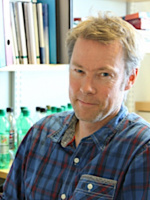Keynote Speakers
Pekka Lappalainen

Pekka did his PhD at EMBL Heidelberg on the biochemistry and structural biology of cytochrome oxidase, and then studied actin dynamics of budding yeast as a post-doc at the UC Berkeley. After his successful time at the USA, he returned to his home country Finland as a group leader at the University of Helsinki. His research interest is centered on the fundamental properties of actin, and its various functions in cells; such as assembly of actomyosin bundles and the interplay between plasma membrane and actin dynamics. The Lappalainen laboratory uses diverse biophysical, biochemical and cell biology approaches to unravel how the functions and regulation of actin.
We cannot wait to listen to a time-contracting keynote session about leading-edge research in the field of actin regulation!
Eva Frickel

After her PhD investigating protein folding regulation in Zurich, Eva went to the Whitehead Institute at MIT to work on immune surveillance of Toxoplasma gondii and the generation of parasite epitopes for recognition by CD8 T cells. Today, Eva is leading the Host-Toxoplasma interaction laboratory at the Institute of Microbiology and Infection at the University of Birmingham, UK. Her work entails how human host cells of various types attack and defend themselves against Toxoplasma gondii and Salmonella typhimurium. Eva’s lab uses various cell lines, primary cells and stem cell-derived models to uncover novel innate immune mechanisms. Eva’s lab also has an interest in developing cutting-edge tools to facilitate this research, having recently assembled an artificial intelligence driven image analysis pipeline enabling unbiased automated high-throughput microscopy of host-pathogen interaction (www.hrman.org).
In contrast to infection biology, we are looking forward to a symbiotic exchange with Eva. We are happy to host her as one of our keynote speakers at our conference and are excited to hear about her recent findings!
Alexandre Roulin

Alexandre obtained his PhD in evolutionary ecology at the University of Bern and then first moved to Cambridge, and later to Montpellier for postdoctoral research projects. In 2004 he returned to Switzerland to take a group leader position at the University of Lausanne. Since his PhD days, his main research focuses on trying to understand the evolution and maintenance of genetic color polymorphism in owls. His work revealed that different color patterns correlate with certain phenotypic traits. Alexandre and his group are now establishing new methods for measuring gene expression levels to study the melanocortin system in wild-living owls.
We are honored that Alexandre wants to join our polymorphic swarm of PhD students and are looking forward to his keynote presentation!
Wanda Kukulski

Wanda obtained her PhD degree in biophysics at the Biozentrum in Basel. Afterwards she moved on to a postdoctoral position at the EMBL Heidelberg where she focused on correlative light and electron microscopy (CLEM). Her CLEM protocols became a gold standard and enabled structural insight into various biological processes. After her time in Germany, she became a group leader at the LMB in Cambridge. Wanda’s research focuses on membrane organisation and how it contributes to cellular functions. She is particularly interested in inter-membrane communication between organelles and pushes this field with her expertise in cutting edge imaging methodologies. She recently was awarded with an EMBO Young Investigator Award.
We are looking forward to an enlightening keynote talk that gives the motto ‘seeing is believing’ a new perspective!
Pascal Fender

Pascal started to work on adenoviruses during his PhD in Grenoble and has stayed in the field ever since. After completing a post-doc in industry, he returned to Grenoble and was promoted shortly afterwards to run his own group at the Institut de Biologie Structurale. Pascal uses biochemical and structural biology approaches, particularly electron microscopy, to gain insight into adenovirus architecture and their function in receptor binding. For instance, the Fender group recently identified in collaboration with André Lieber (Seattle) Desmoglein 2 as a receptor for human adenovirus serotype B and deciphered the molecular interactions underlying this interaction. Furthermore, Pascal and his co-workers are developing therapeutic vectors for vaccinations based on the exceptionally stable dodecahedron adenovirus capsid.
We are already excited to hear Pascal’s talk about the EMazing world of virology!
